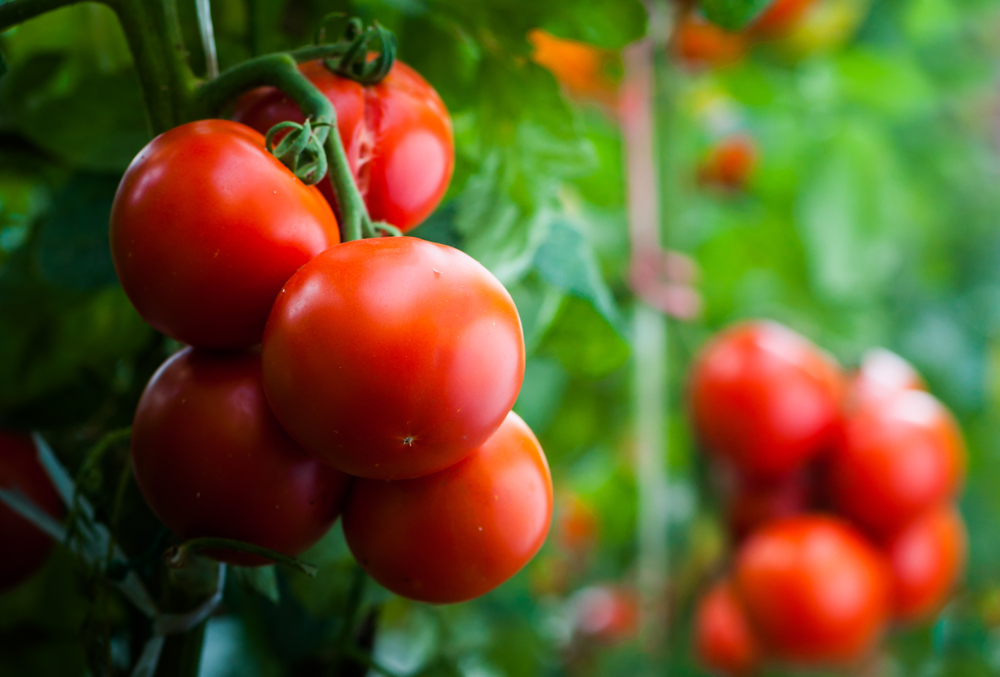Crop Production

Tomatoes are one crop that can have a lot of disease issues for growers. This article discusses a few of the more common tomato problems. Growers should keep in mind that many tomato problems are hard to identify in the field.
Blossom-End Rot
Blossom-end rot is a common tomato disorder, but can affect many other crops including pepper, watermelon, squash, etc. Caused by a lack of calcium in plants, it presents itself as decay, usually on the blossom end of fruit. The lack of calcium in the plant could be a result of deficient calcium in the soil. However, it could also be the result of the roots being too wet or too dry (stress).
The best thing to do for blossom-end rot would be to perform a soil test and add the recommended levels of nutrients. The soil pH should be maintained between 6.0 and 6.5. Mulch the plants and irrigate when needed. It is important to note that spraying calcium products on the leaves of plants may not be the best option because it is easy to burn the leaves and the plant can not take in the recommended amount of calcium through the leaves. Calcium fertilizers are available and will increase the calcium in the plant by providing it to the roots.
Blossom Drop
Blossom drop is not a disease but is one of the common tomato problems. It appears on some tomato varieties when daytime temperatures exceed 85oF and nighttime temperatures stay above 72oF. Often times it is the high nighttime temperatures that reduce flowering the most. Plants should start producing again as temperatures become more favorable. Many heat set tomato varieties are available that continue to set fruit in higher temperatures.
Wilt Diseases
There are three common wilt diseases of tomatoes; fusarium wilt, southern blight, and bacterial wilt.
Southern Blight
Southern blight symptoms include wilting and yellowing of the plant along with a white fungal growth at the plant base. Best management practice includes destroying infected plants and crop rotation. It is advisable not to plant tomatoes or susceptible crops in the tomato family more than once every four years.
Fusarium Wilt
Fusarium wilt enters the plant through the roots and can cause the plant to wilt. It may start with one stem before spreading to the rest of the plant. Cutting into the stem at the base will show a brown discoloration in the vascular system. This fungus may persist in the soil for many years so crop rotations may not help with this disease, but many fusarium wilt resistant tomato varieties are available.
Bacterial Wilt
Bacterial wilt causes plants to wilt and die rapidly without any other symptoms. To check for bacterial wilt a grower can place a cut section of stem in water. If bacterial wilt disease is present, a white milky substance will seep from the stem. A management option is the same four year rotation as for southern blight.
Tomato Spotted Wilt
Several viruses affect tomato plants, but tomato spotted wilt is usually the most common virus. The plants’ growth rate will become stunted, they will turn a lighter green color, and the leaf veins may have a purplish tint. If fruit develops, they will have ringspots and quality will suffer.
Thrips commonly spread the disease. Thrips feed on many plants, including weeds, around the garden/field. Managing thrips by destroying weeds adjacent to the field may help but may not stop the problem. Planting tomato spotted wilt resistant varieties is the best method for managing the disease. Many tomato spotted wilt resistant varieties are available.
Blight
Early blight, late blight, septoria leaf spot, bacterial spot, and bacterial speck are common foliar tomato diseases. Management options include planting disease free seeds or transplants, crop rotation, mulching, and no overhead irrigation. A regular fungicide spray program will help as well. For information on spraying vegetables, contact your county Extension office.
Diagnostic Tests
Tomato plants can get many diseases other than the ones mentioned in this article. It is sometimes hard to identify diseases from pictures or descriptions and for a positive diagnosis a sample may need to be sent to our lab at Auburn or Birmingham. Information for sending samples can be found on our web site or by visiting your local Extension office. There is a small fee of $10 to $15 for sending samples, but losing a crop is much more expensive.
Reduce Gardening Problems
Choose a location with well-drained soil or at least try to avoid low areas that stand in water for extended periods. An area that receives full sun and is close to a water source would also be beneficial. Having more than one garden spot will allow you to grow summer cover crops and aid in crop rotation as well. Growers should perform soil tests to determine the nutrient levels in the soil in order to determine what nutrients need to be added.
Plant nutrition is a common problem that many overlook. Plant disease resistant seed/plants as much as possible, many problems can be avoided at planting. Amending the soil with organic matter, weed control, mulch, and drip irrigation helps reduce stress on the plants which in turn makes plants healthier.

